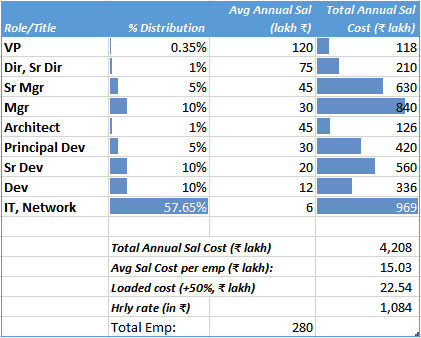
An article published on an online news portal (reproduced from a business daily) claimed that "Flipkart's 'Big Billion Day' was planned over more than 700,000 man hours (six months of work put in by 280 people over 14 hours every day) to get the back-end systems ready." This is a stupendous achievement by any yardstick, and all the more creditable given that Flipkart's infrastructure is nothing to scoff at to begin with, and which is rarely known to keel over during traffic surges. Despite all this preparation however, Flipkart did experience issues during its big sale, which led to its founders issuing a public apology - an act of entrepreneurial humility that was well appreciated by many.
The article states that Flipkart "clocked a gross merchandise value (GMV) of $100 million". But what is "GMV"? According to Investopedia, Gross Merchandise Value, abbreviated as GMV, is "The total value of merchandise sold over a given period of time through a customer to customer exchange site. It is a measure of the growth of the business, or use of the site to sell merchandise owned by others." But there is some confusion as to what GMV actually means. This arises from the fact that GMV is not a standard accounting term. For instance, a search for "GMV" or for "Gross Merchandise Value" on the web site of The Institute of Chartered Accountants of India throws up zero results. GMV's definition differs based on each e-commerce vendor's assumptions. Therefore, if an item's price is marked at Rs 100, and Flipkart sells ten such items for Rs 70 each, is the GMV 700 or Rs 1000? Let us be generous and assume that GMV refers to the total sale value, before discounts - that would make it easier for Flipkart to claim they clocked in a hundred million dollars in GMV. Plus it is the logical thing to do - from a marketing perspective.
Next, the average discount offered at leading e-commerce sites like Flipkart can be 20%, 30%, or even touching 40% in some cases. It is generally understood, that at least for items like books, wholesalers get a discount of 40% off the list price from publishers. This can be lower for other categories of goods like electronics (retailers do not get the Apple iPhone at 40% off the list price - at least one hopes so!), but can be higher for other categories like clothes. Therefore, assuming a discount of 40% (on the higher end), it means that for the hundred million dollars worth of GMV, Flipkart's cost for those goods was 60 million dollars. Assuming they passed off 20% of the GMV as a discount to the end customer - and discounts were generally higher than 20% during that sale period, it leaves them with a gross profit of twenty million dollars, into which they have to squeeze all their costs, to be profitable. Hold that number in your mind for a minute.
Let us now take a closer look at the other statement in the article's sub-heading, which says, "Flipkart's 'Big Billion Day' was planned over more than 700,000 man hours (six months of work put in by 280 people over 14 hours every day) to get the back-end systems ready." If Flipkart, as the article claims, took 700,000 man hours (the politically correct phrase would be "person-hours", but we will grant the author of the article some leeway here), that translates to a little over $20 million that the company spent on this sale in getting its network infrastructure scaled up. How? My assumptions are, and there are many, many assumptions here, that the base salary for the Flipkart employees that worked on this initiative is Rs 26 lakhs per annum (yes, yes, more on this later). Second, I have taken a year as having 2080 work-hours (52 weeks, times 40 hours per week). Third, I assume that the loaded cost adds 50% on top of a person's actual salary - or Annual Guaranteed Pay (AGP) as is also sometimes referred to. Fourth, I take Rs 65 to a dollar as my exchange rate (the exchange rate was lower a couple of months back; the numbers would look worse - for Flipkart - if I were to use those). Using these assumptions, at an aggregate level, this means a hundred and thirty crores rupees, or US$20 million. You can see the calculations, and the assumptions, in the figure at the end. Hold this second figure of $20 million in your head.

Compare the two figures now. For a maximum gross profit of 20 million dollars from their big billion sale, Flipkart had to spend the same sum on upgrading their hardware and network infrastructure to deal with the traffic to their web site. Ignoring other fixed costs, did Flipkart make money, any money at all from their sale?
One could argue that there are many assumptions in my calculations, and I do agree that there are several. You can plug in your own numbers and the mileage will surely vary, but not by much, I expect. I have used three different sets of numbers (see below)

Second, the argument could be made that these are not contractors who are paid by the hour, and many worked for "over fourteen hours every day" - which is not uncommon for young, passionate employees working at hot startups (I regularly clock in 12 hour workdays, and I am no longer young, nor do I work for a start-up!) On the other hand, I could argue that Rs 26 lakh is not that wildly off the mark a figure, given that Flipkart recently made offers to fresh graduates at IIT-Kharagpur where the average salary offered was Rs 20 lakh - for engineers with zero work experience. Not everyone working on the preparation for the Big Billion Sale would have been a fresh-out-of-college greenhorn. The loaded cost factor could be more than 50%, given that Flipkart would be handing out stock options to its employees, and having other on-premise perks (the role model for all young startups seems to be Google).
But to fixate on the specifics of any one number here would be to miss the wood for the trees, in a manner of speaking. It is not the main point of my post either. The article itself reveals two hidden points. The first is that this article in the business daily is a successful implementation of a company's PR or marketing department getting its point of view across to a news organisation, not in the form of a press release, but as a news article. It lends an air of neutrality and credibility even as it presents the company's point of view, in an unquestioned manner. There is no mention of the article being a paid advertorial. Second, it also serves as an eloquent advertisement for Flipkart's formidable computing prowess and infrastructure. To that end, it serves as a signal of intent to its competitors, especially Amazon, that Flipkart won't be found wanting when it comes to competing with the big bad daddies of the global e-commerce world. In the end, however, the inescapable question remains - to drive its top-line, is Flipkart caught in a situation where the more it sells, the more it loses? Is it finding it difficult to get economies of scale? Or is it still in the growth stage, where margins and profits take a backseat to marketshare and growth? With more than a thousand crores in annual revenues, if one of the most successful e-tailers in the country finds itself in this bind, the other, smaller players will find the going much tougher. Is the online e-commerce space headed for a brutal shakeout in 2015?
Views expressed are the author's own